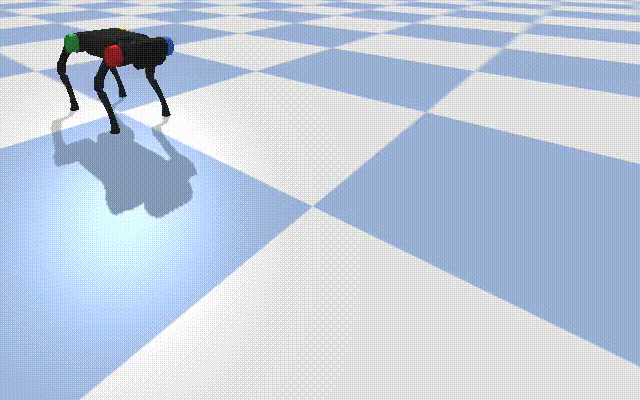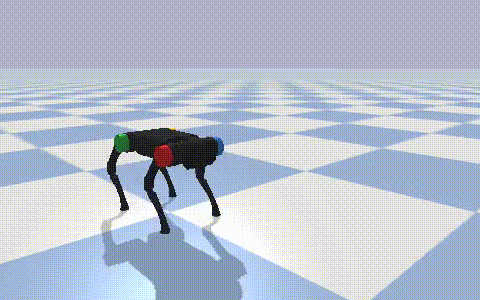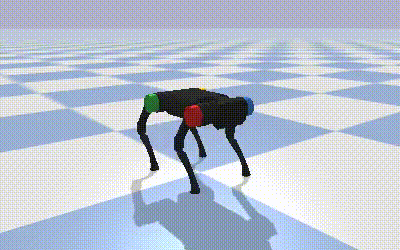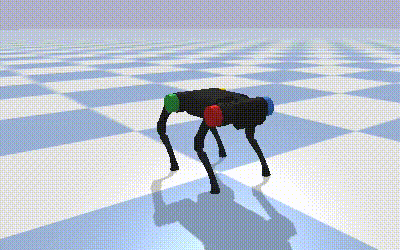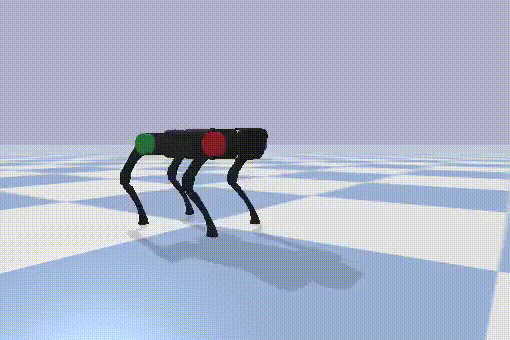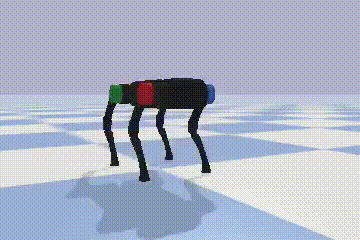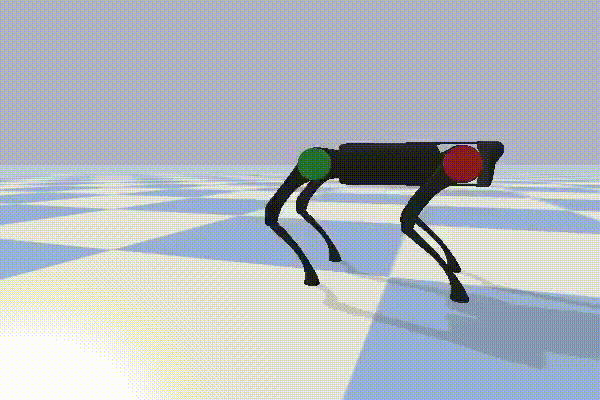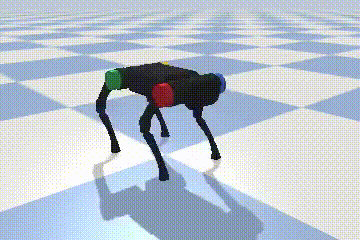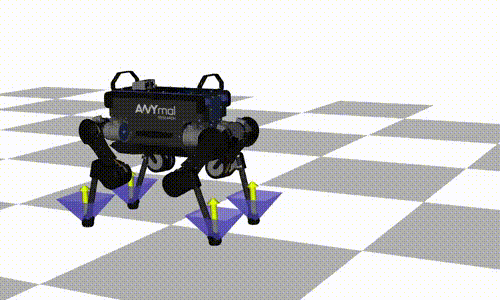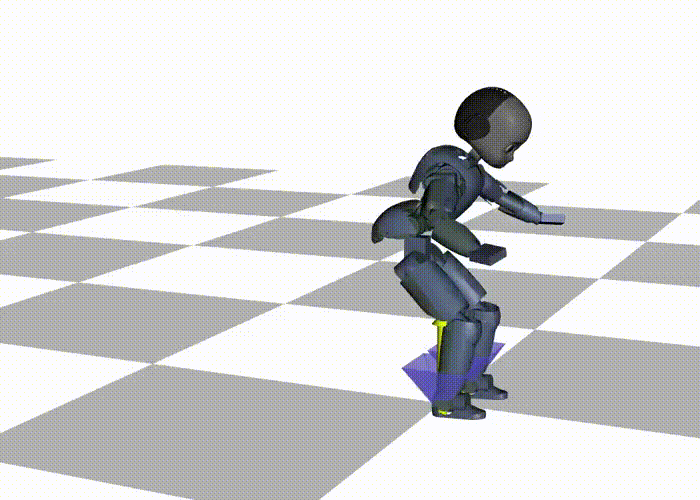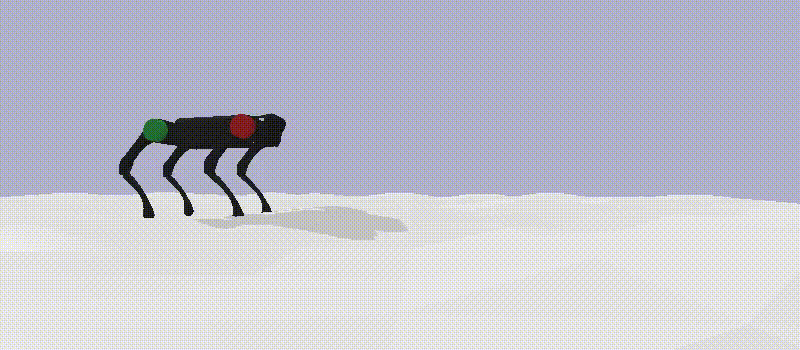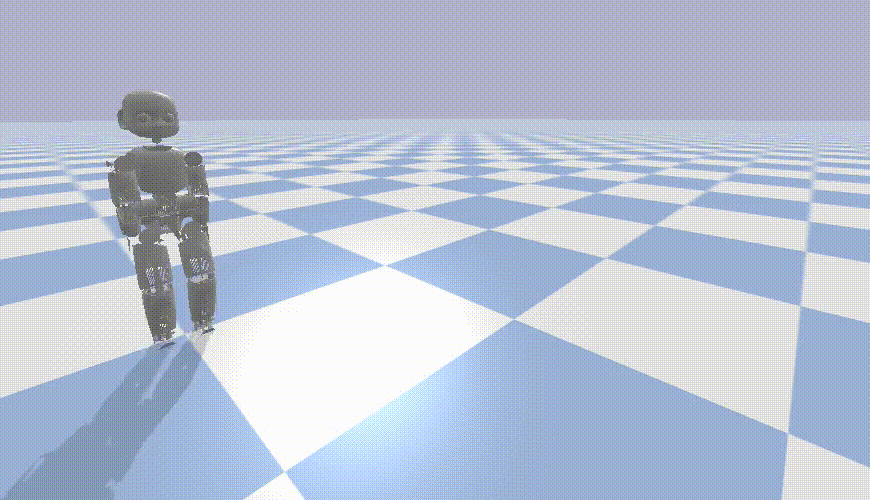- Direct multiple-shooting method based on the lifted contact dynamics / inverse dynamics.
- Riccati recursion algorithm for switching time optimization (STO) problems and efficient pure-state equality constraint handling.
- Primal-dual interior point method for inequality constraints.
- Very fast computation of rigid body dynamics and its sensitivities thanks to Pinocchio.
- Ubuntu 22.04, 20.04, and 18.04 (possibly Mac OSX, but not well tested)
- gcc (at least C++11 is required), CMake (at least version 3.11)
- Eigen3, Pinocchio ,
- Python3, NumPy (for Python binding)
- gepetto-viewer-corba and/or meshcat-python (optional to visualize the solution trajectory in Python)
- PyBullet (optional to simulate MPC examples)
- Install the latest stable version of Eigen3 by
sudo apt install libeigen3-dev
- Install the latest stable version of Pinocchio by following the instruction
- Clone this repository and change the directory as
git clone https://github.com/mayataka/robotoc
cd robotoc
- Build and install
robotocas
mkdir build && cd build
cmake .. -DCMAKE_BUILD_TYPE=Release
make install -j$(nproc)
NOTE: if you want to maximize the performance, use CMake option
cmake .. -DCMAKE_BUILD_TYPE=Release -DOPTIMIZE_FOR_NATIVE=ON
- If you want to visualize the solution trajectory with Python, you have to install gepetto-viewer-corba by
sudo apt update && sudo apt install robotpkg-py38-qt5-gepetto-viewer-corba -y
and/or meshcat-python by
pip install meshcat
- If you do not want to install the Python bindings, change the CMake configuration as
cmake .. -DBUILD_PYTHON_INTERFACE=OFF
- In OSX, explicitly set g++ as the complier. First, find the path of g++ as
ls -l /usr/local/bin | grep g++
Then set the full path in the cmake as
cmake .. -DCMAKE_CXX_COMPILER=FULL_PATH_TO_GPLUSPLUS
You can link your executables to robotoc by writing CMakeLists.txt, e.g., as
find_package(robotoc REQUIRED)
add_executable(
YOUR_EXECTABLE
YOUR_EXECTABLE.cpp
)
target_link_libraries(
YOUR_EXECTABLE
PRIVATE
robotoc::robotoc
)
Suppose that the Python version is 3.8. The Python bindings will then be installed at ROBOTOC_INSTALL_DIR/lib/python3.8/site-packages where ROBOTOC_INSTALL_DIR is the install directory of robotoc configured in CMake (e.g., by -DCMAKE_INSTALL_PREFIX).
To use the installed Python library, it is convenient to set the environment variable as
export PYTHONPATH=ROBOTOC_INSTALL_DIR/lib/python3.8/site-packages:$PYTHONPATH
e.g., in ~/.bashrc. Note that if you use another Python version than python3.8, please adapt it.
The following three solvers are provided:
OCPSolver: Solves the OCP for rigid-body systems (possibly with contacts) by using Riccati recursion. Can optimize the switching times and the trajectories simultaneously.UnconstrOCPSolver: Solves the OCP for "unconstrained" rigid-body systems by using Riccati recursion.UnconstrParNMPCSolver: Solves the OCP for "unconstrained" rigid-body systems by using ParNMPC algorithm.
where "unconstrained" rigid-body systems are systems without any contacts or a floating-base.
Examples of these solvers are found in examples directory.
Further explanations are found at https://mayataka.github.io/robotoc/page_examples.html.
OCPSolvercan solve the switching time optimization (STO) problem, which optimizes the trajectory and the contact timings simultaneously.- The following videos display the solution trajectory of the STO problems (
anymal/python/jumping_sto.pyandicub/python/jumping_sto.py).
- The following example implementations of whole-body MPC are provided:
MPCCrawl: MPC withOCPSolverfor the crawl gait of quadrupedal robots.MPCTrot: MPC withOCPSolverfor the trot gait of quadrupedal robots.MPCPace: MPC withOCPSolverfor the pace gait of quadrupedal robots.MPCFlyingTrot: MPC withOCPSolverfor the flying trot gait of quadrupedal robots.MPCJump: MPC withOCPSolverfor the jump motion of quadrupedal or bipedal robots.MPCBipedWalk: MPC withOCPSolverfor the walking motion of bipedal robots.
- You can find the simulations of these MPC at
a1/mpc,anymal/mpc, andicub/mpc. - You need PyBullet for the MPC simulations. (easy to install, e.g., by
pip install pybullet) - The following videos display the simulation results of quadrupedal walking on rough terrain (
a1/mpc/trot_terrain.py) and bipedal walking (icub/mpc/walk.py).
More detailed documentation is available at https://mayataka.github.io/robotoc/.
Our tutorials on robotoc is available at robotoc_tutorial.
- Citing the STO algorithm of
OCPSolver:
@misc{katayama2021sto,
title={Structure-exploiting {N}ewton-type method for optimal control of switched systems},
author={Sotaro Katayama and Toshiyuki Ohtsuka},
url={arXiv:2112.07232},
eprint={2112.07232},
archivePrefix={arXiv}
year={2021}}
- Citing
OCPSolverwithout the switching time optimization (STO):
@inproceedings{katayama2022lifted,
title={Lifted contact dynamics for efficient optimal control of rigid body systems with contacts},
author={Sotaro Katayama and Toshiyuki Ohtsuka},
booktitle={{2022 IEEE/RSJ International Conference on Intelligent Robots and Systems (IROS 2022) (to appear)}},
year={2022}}
- Citing
UnconstrOCPSolverandUnconstrParNMPCSolver(the repository name wasidocpin this paper (https://github.com/mayataka/idocp)):
@inproceedings{katayama2021idocp,
title={Efficient solution method based on inverse dynamics for optimal control problems of rigid body systems},
author={Sotaro Katayama and Toshiyuki Ohtsuka},
booktitle={{2021 IEEE International Conference on Robotics and Automation (ICRA)}},
pages={2070--2076},
year={2021}}
- S. Katayama and T. Ohtsuka, "Whole-body model predictive control with rigid contacts via online switching time optimization," 2022 IEEE/RSJ International Conference on Intelligent Robots and Systems (IROS 2022) (to appear), https://arxiv.org/abs/2203.00997, 2022
- S. Katayama and T. Ohtsuka, "Structure-exploiting Newton-type method for optimal control of switched systems," https://arxiv.org/abs/2112.07232, 2021
- S. Katayama and T. Ohtsuka, Lifted contact dynamics for efficient optimal control of rigid body systems with contacts, 2022 IEEE/RSJ International Conference on Intelligent Robots and Systems (IROS) (to appear), https://arxiv.org/abs/2108.01781, 2022
- S. Katayama and T. Ohtsuka, Efficient Riccati recursion for optimal control problems with pure-state equality constraints, 2022 American Control Conference (ACC), pp. 3579-3586, 2022
- S. Katayama and T. Ohtsuka, Efficient solution method based on inverse dynamics for optimal control problems of rigid body systems, 2021 IEEE International Conference on Robotics and Automation (ICRA), pp.2070-2076, 2021
- H. Deng and T. Ohtsuka, A parallel Newton-type method for nonlinear model predictive control, Automatica, Vol. 109, pp. 108560, 2019

